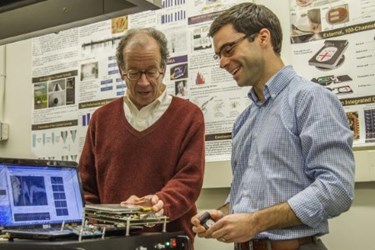Wireless Brain Sensor Could Pave Way For Improved Neuroprosthetics
By Chuck Seegert, Ph.D.

A wireless system for brain studies now enables the remote acquisition of high-fidelity neural data from animal models. Previously, wires and cables constrained these types of experiments to artificial scenarios. With the new system, neural data can be obtained during normal, unrehearsed activities.
Studying neural signals currently depends on direct cable connections between electrodes implanted in an animal’s brain and the computer used to download and analyze the data. While effective in some scenarios, at other times the cables interfere with obtaining good data. Many natural behaviors — like roaming, foraging, and sleeping — would provide interesting, clinically relevant data for studies, but the hardwired connections interfere with those types of observations.
“The brain sensor is opening unprecedented opportunities for the development of neuroprosthetic treatments in natural and unconstrained environments,” said Grégoire Courtine, the study’s co-author and a professor at École polytechnique fédérale de Lausanne, in the press release.
The new, lightweight, and compact device was developed by a research team from Brown University, according to a recent press release. Weighing in at only 46.1 grams, the head-mounted instrument is only 5 cm in its largest dimension. A 100-channel transmitter is coupled with a four-antenna receiver, making the device similar to a WiFi router. Electrodes implanted in the brain are connected through a small hole in the subject’s skull, and advanced signal processing optimizes the transmitter’s signal when the animal is on the move.
To demonstrate the power of this new system, the team monitored neural feedback in populations of freely interacting nonhuman primates, according to a recent study published by the team in the journal Neuron. The system was able to record a full spectrum of cortical, electrophysiological signals that were generated during natural locomotion, as well as the uninhibited sleep-wake cycle. While being electrically safe, the new instrumentation is compatible with most existing neural probes.
“We were able to observe motor cortical dynamics during locomotion, yielding insight into how the brain computes output commands sent to the legs to control walking,” said lead author David Borton, now assistant professor of engineering at Brown, in the press release.
To make this level of performance possible, the team developed a custom, low-power, high-efficiency transmitter that dissipates power orders of magnitude lower than other conventional, commercially available transceivers, according to the press release. Though the power consumption is lower, the design still allows high-speed data transfer at up to 200 megabits per second. Powered by a single rechargeable AA battery, the device can last up to 48 hours at a time.
“We hope that the wireless neurosensor will change the canonical paradigm of neuroscience research, enabling scientists to explore the nervous system within its natural context and without the use of tethering cables,” Borton said in the press release. “Subjects are free to roam, forage, sleep, etc., all while the researchers are observing the brain activity. We are very excited to see how the neuroscience community leverages this platform.”
Remote transmission of physiological data is an area that is of significant interest not just in the neuroscience field, but also in the collection of biometrics. Recently, textiles that can be made into wearable sensors have been developed to help in this endeavor.
Image Credit: Brown University
